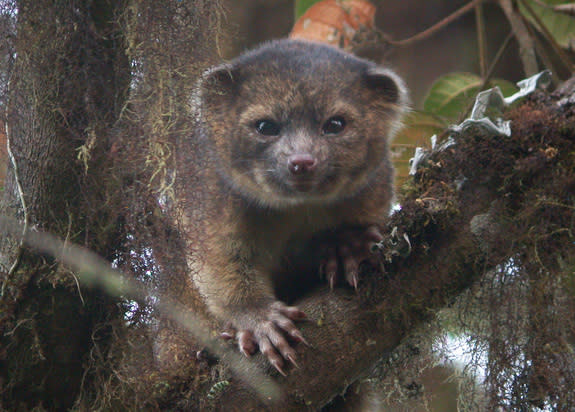Furry Little Carnivore, Once Shown in Zoos, Is a New Species
In the cloud forests of Ecuador, scientists have "discovered" the olinguito, the first new carnivore species reported in the Western Hemisphere in 35 years.
The olinguito (Bassaricyon neblina) is a century-old case of missed connections. The furry, 2-lb. animal resembles its fellow olingos, which are sometimes called "cat monkeys" because they look like house cats with long tails. But the orange-brown olinguito eluded classification by scientists for more than 100 years, despite being observed in the wild, ending up in museum collections and even being exhibited at the Louisville Zoo, the National Zoo and the Bronx Zoo in the 1960s and 1970s, according to a statement from the Smithsonian's National Museum of Natural History.
Finally, during a recent effort to classify the world's olingos, which researchers have argued may be one or up to five different species, Smithsonian researchers noticed that some of the olingo skulls looked odd. (The researchers examined more than 95 percent of the olingo skulls kept in museums around the world, the Smithsonian said in the statement.) These strange specimens had teeth and skulls that were smaller and shaped differently than those of other olingos. [6 Strange Species Discovered in Museums]
Preserved pelts revealed that the olingos with unusual skulls also had smaller bodies, with longer, denser coats. Field notes from the early 1900s indicated the animals were collected in Colombia, Panama, Costa Rica and Nicaragua at about 3,250 to 5,500 feet (1,000 to 1,700 meters) above sea level — much higher than the olingo's known range, according to the new study.
Working with Miguel Pinto, a zoologist from Ecuador, the researchers tracked down a living example of the new species.
"The data from the old specimens gave us an idea of where to look, but it still seemed like a shot in the dark," Roland Kays, study co-author and a zoologist at the North Carolina Museum of Natural Sciences in Raleigh, said in the statement. "But these Andean forests are so amazing that even if we didn't find the animal we were looking for, I knew our team would discover something cool along the way."
The team found the nocturnal carnivores on the western slopes of the Andes, prowling the cloud forests for figs, nectar and insects. The olinguitos occasionally also eat birds, mice and other small animals. Cloud forests are tropical, moist forests with persistent fog or cloud cover. A genetic analysis proved the olinguitos were a distinct species.
The new species is described today (Aug. 15) in the journal ZooKeys.
"Proving that a species exists and giving it a name is where everything starts," lead study author Kristofer Helgen, a zoologist at the Smithsonian's National Museum of Natural History, said in the statement. "This is a beautiful animal, but we know so little about it. How many countries does it live in? What else can we learn about its behavior? What do we need to do to ensure its conservation?"
Olingos are listed as a species of least concern on the International Union for Conservation of Nature's Red List, the most widely recognized list of threatened and endangered species.
Email Becky Oskin or follow her @beckyoskin. Follow us @OAPlanet, Facebook & Google+. Original article on LiveScience's OurAmazingPlanet.
Copyright 2013 LiveScience, a TechMediaNetwork company. All rights reserved. This material may not be published, broadcast, rewritten or redistributed.



